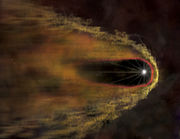 The blue and green are optical images of the field in which the black widow pulsar is found, the green indicating the H-alpha bow shock. The red and white are the colors of the shock structures discovered in x-ray by the Chandra X-ray Observatory. | |
| Observation data Epoch J2000 Equinox J2000 | |
|---|---|
| Constellation | Sagitta |
| Right ascension | 19 59 36.77 |
| Declination | +20° 48′ 15.12″ |
| Apparent magnitude (V) | 20.4 |
| Details | |
| Rotation | 1.60734 ms |
| Other designations | |
| QX Sge, PSR J1959+2048, PSR B1957+20 | |
| Database references | |
| SIMBAD | data |
The Black Widow Pulsar (PSR B1957+20) is an eclipsing binary millisecond pulsar in the Milky Way. Discovered in 1988, it is located roughly 6,500 light-years (2,000 parsecs) away from Earth. It orbits with a brown dwarf or Super-Jupiter companion with a period of 9.2 hours with an eclipse duration of approximately 20 minutes. When it was discovered, it was the first such pulsar known. The prevailing theoretical explanation for the system implied that the companion is being destroyed by the strong powerful outflows, or winds, of high-energy particles caused by the neutron star; thus, the sobriquet black widow was applied to the object. Subsequent to this, other objects with similar features have been discovered, and the name has been applied to the class of millisecond pulsars with an ablating companion, as of February 2023 around 41 black widows are known to exist.

Later observations of the object showed a bow shock in H-alpha and a smaller-in-extent shock seen in X-rays (as observed by the Chandra X-ray Observatory), indicating a forward velocity of approximately a million kilometers per hour.
In 2010, it was estimated that the neutron star's mass was at least and possibly as high as (the latter of which, if true, would surpass PSR J0740+6620 for the title of most massive neutron star yet detected and place it within range of the Tolman–Oppenheimer–Volkoff limit). In January 2023 the upper limit was revised down to
Planets
The pulsar has a substellar companion, possibly a brown dwarf.
| Companion (in order from star) |
Mass | Semimajor axis (AU) |
Orbital period (days) |
Eccentricity | Inclination | Radius |
|---|---|---|---|---|---|---|
| b | 22 MJ | — | 0.38 | — | — | — |
Gallery
Artist impressions of the Black Widow Pulsar.
-
 Artist's impression of the pulsar surrounded by its bow shock. White rays indicate particles of matter and antimatter being spewed from the star. Its companion star is too close to the pulsar to be visible at this scale.
Artist's impression of the pulsar surrounded by its bow shock. White rays indicate particles of matter and antimatter being spewed from the star. Its companion star is too close to the pulsar to be visible at this scale.
-
 Depiction of the same pulsar one million times closer showing the effect of its wind on its companion star, which is evaporating. The bow shock is too large to be shown, and at this scale would extend more than 15 miles (24 km) beyond the edge of the computer screen.
Depiction of the same pulsar one million times closer showing the effect of its wind on its companion star, which is evaporating. The bow shock is too large to be shown, and at this scale would extend more than 15 miles (24 km) beyond the edge of the computer screen.
See also
References
- Fruchter, A. S.; Stinebring, D. R.; Taylor, J. H. (May 19, 1988). "A millisecond pulsar in an eclipsing binary". Nature. 333 (6170): 237–9. Bibcode:1988Natur.333..237F. doi:10.1038/333237a0. S2CID 4337525.
- Swihart, Samuel J.; Strader, Jay; Chomiuk, Laura; Aydi, Elias; Sokolovsky, Kirill V.; Ray, Paul S.; Kerr, Matthew (December 1, 2022). "A New Flaring Black Widow Candidate and Demographics of Black Widow Millisecond Pulsars in the Galactic Field". The Astrophysical Journal. 941 (2): 199. arXiv:2210.16295. Bibcode:2022ApJ...941..199S. doi:10.3847/1538-4357/aca2ac. ISSN 0004-637X. S2CID 253224234.
- Cassese, Ben (February 17, 2023). "A New Spider Joins a Deadly Club". AAS Nova. Retrieved February 18, 2023.
- van Paradijs, J.; Allington-Smith, J.; Callanan, P.; Charles, P. A.; Hassall, B. J. M.; Machin, G.; Mason, K. O.; Naylor, T.; Smale, A. P. (August 1988). "Optical observations of the eclipsing binary radio pulsar PSR1957+20". Nature. 334 (6184): 684–686. Bibcode:1988Natur.334..684V. doi:10.1038/334684a0. S2CID 38016452. Retrieved March 5, 2022.
- Chandra Digest (February 27, 2003). "B1957+20: A Cocoon Found Inside the Black Widow's Web". Chandra X-Ray Observatory. Retrieved June 4, 2022.
- Van Kerkwijk, M. H.; Breton, R. P.; Kulkarni, S. R. (2011). "Evidence for a Massive Neutron Star from a Radial-Velocity Study of the Companion to the Black-Widow Pulsar Psr B1957+20". The Astrophysical Journal. 728 (2): 95. arXiv:1009.5427. Bibcode:2011ApJ...728...95V. doi:10.1088/0004-637X/728/2/95. S2CID 37759376.
- Clark, C. J.; Kerr, M.; Barr, E. D.; Bhattacharyya, B.; Breton, R. P.; Bruel, P.; Camilo, F.; Chen, W.; Cognard, I.; Cromartie, H. T.; Deneva, J.; Dhillon, V. S.; Guillemot, L.; Kennedy, M. R.; Kramer, M. (January 26, 2023). "Neutron star mass estimates from gamma-ray eclipses in spider millisecond pulsar binaries". Nature Astronomy. 7 (4): 451–462. arXiv:2301.10995. Bibcode:2023NatAs...7..451C. doi:10.1038/s41550-022-01874-x. ISSN 2397-3366. PMC 10119022. PMID 37096051. S2CID 256274563.
- "Gamma-ray eclipses shed new light on spider pulsars". www.aei.mpg.de. Retrieved January 27, 2023.
- "The Extrasolar Planet Encyclopaedia — PSR B1957+20 b". Extrasolar Planets Encyclopaedia. Archived from the original on September 30, 2020. Retrieved January 18, 2021.
| Constellation of Sagitta | |||||||||||
|---|---|---|---|---|---|---|---|---|---|---|---|
| Stars |
| ||||||||||
| |||||||||||
| |||||||||||
| Nebulae |
| ||||||||||
 and possibly as high as
and possibly as high as  (the latter of which, if true, would surpass
(the latter of which, if true, would surpass 